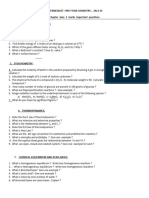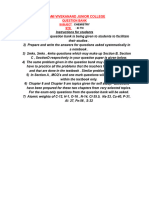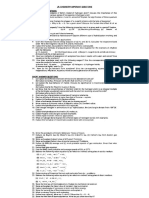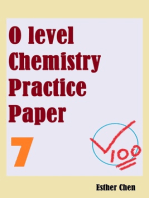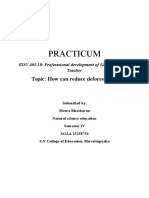Chemistry Question Bank 2024
Uploaded by
harshchaudhari190Chemistry Question Bank 2024
Uploaded by
harshchaudhari190Questions bank for Annual Exam 2024
Std XI Subject-Chemistry
Questions for 1 mark
1) Define radioactivity.
2) State Le-Chatelier's principle.
3) Define molar mass.
4) What is covalent bond?
5) Draw shapes of P orbitals.
6) What is the temperature at absolute zero?
7) Write electronic configuration of an element with atomic number 8.
8) Which alkene is used in the manufacturing of polythene bag ?
9) Define a) mole fraction.b) molarity
10) Find the no.of neutrons present in 714N, 816O, 1531P,1735Cl etc.
11)Which elements are known as representative elements?
12)Write any two examples of nucleophiles
13)Write any two examples of electrophiles.
14)Define adsorption.
15) Which type of hybridization is observed in carbon of acetylene?
16) Correct functional group of aldehyde/ketone/acid/ether/ester/amino/nitro/amide/cyanide
17) State Huckel’s rule
18)What are the maximum number of electrons present in 3p and 3d orbitals?
19) Define -drug
20)Write any two examples of Antiseptics.
21)Elements which belongs to group 17 are
22)Identify the product of the following reaction :
23) Give the name of the radioactive element present in group 2nd .
24)Gas on activated charcoal surface is an example of _______
25) Define - inductive effect.
26) Define - electrometric effect
27)The overlap of atomic orbital which can only form Pi bond is ___
28) State Markovnikov’s rule
29) Chemical name of Aspirin
30)Define - Molarity.
31)1-Chloropropane on treatment with alc.KOH produces ______
32) Write the name of the product formed when ethene reacts with ozone.
33) Give any 2 uses of Acetylene
34) Write the Names of the two large scale sources of Benzene.
35)Where the lanthanides are placed in periodic table ?
36) Define- catenation
37) Name the Industrial method for the preparation of Ammonia.
Questions for 2/3/4 marks.
1) State and explain Boyles law.
2) State and explain Charle’s law.
3) Give any 4 characteristics of the d block elements. Write any 4 charateristics of P-block elements
4) Give any 4 characteristics of f block elements.
5) Distinguish between Sigma and Pi bond.
6) Derive the relationship between Kc and Kp.
7) Calculate the molarity of NaOH in the solution prepared by dissolving its 4 gram in
enough water to form 250 ml of the solution.
8) Distinguish between oxidation and reduction.
9) Write the equilibrium constant expression For the reaction.
2NaHCO3 (s) ---------> Na2CO3 (s) + CO2 (g) + H2O (g)
Deduce the unit of Kc from the expression.
10) Distinguish between adsorption and absorption.
11) Explain why first ionization enthalpy values are always larger than
second ionization enthalpy values.
12) State and explain Hund’s rule of maximum multiplicity.
13) Write a short note on principal Quantum number.
14) Give the features of long form of periodic table.
15) Calculate the molarity of KOH in the solution prepared by dissolving its 40 gram in
enough water to form one litre of the solution.
16) What is the half-life of radiactive element?
Derive the relationship between half-life and decay constant.
17) Balance the following reaction by oxidation number method.
a)CuO + NH3 Cu + N2 + H2O
b) Cr2O7 2-(aq) + SO32-(aq) Cr3+(aq) + SO42-(aq) ( acidic medium )
18) Define atomic radius. Give it trends across a period and down the group.
19) Define electronegativity. Give its trends across a period and down the group.
20) Equal concentrations of hydrogen and iodine are mixed in a closed container at
700 K and allowed to come to equilibrium. If the concentration of HI at equilibrium is
0.85 mol/dm3 What are equilibrium concentrations of H2 and I2? If Kc=54
at this temperature.
21) Calculate the number of moles and molecules of
a) 20 gram of acetic acid b) 2 gram of H2 c) 7 gram of N2
d) Calculate number of moles and molecules of ammonia (NH3)gas in a volume 67.2 dm3 of it
measured at STP.
22) Give any one example for each of the following : a) Incomplete octet b) Expanded octet.
23) Define hybridization with the help of neat diagram. Explain the formation and
geometry of CH4 molecule based on hybridisation.
24) Define hybridization with the help of neat diagram. Explain the formation and
geometry of C2H2 molecule based on hybridisation.
25) State and explain law Mass action.
26) Hydrocarbon contains C= 85.71%. And H= 14.29%. Calculate its empirical formula.
27) Carbohydrate contains 40% of carbon and 6.66% hydrogen.
If its molecular weight is 180. Determine its molecular formula.
28) Calculate the oxidation number of underlined atoms
a) HNO3 b) K2Cr2O7 C) H2SO4
29) What is allotropy? List the various allotropes of Carbon and Phosphorous.
30) What are disinfectants? Explain with suitable Example.
31) What is the action of a) H2O b) Cl2 with aluminium?
32) Give any four uses of dihydrogen.
33) Write a note on position Isomerism.
34)Which of the following compounds obeys Huckel’s rule?
a) b)
35)How is Dihydrogen prepared by laboratory methods?
36)What is covalent bond? Explain formation of Cl2 molecule on the basis of Octet rule.
37)Write the names of two large scale sources of Benzene. How will you prepare Ethyne from
a) Bromoethane b) Methane .
38) How will you prepare Ethyne from a) 1,2-dibromoethane b) Calcium Carbide?
39) Explain Nitration of Benzene.
40) Distinguish between a) aromatic and aliphatic compounds. B) adsorption and absorption
41) How will you convert a) ethane to bromoethane b) Phenol to benzene?
42) Hydrogen shows similarity with alkali metals as well as halogens. Explain
43) Write a note on Homologous series.
44)Write a note on a) Friedel-Craft’s alkylation. B) Markovnikov’s rule.
45) Explain Sulphonation of Benzene.
46) Alkyne shows more acidity than alkenes and alkanes. Explain.
47)Give any four postulates of VBT.
48) Write a note on Hydroboration Oxidation of alkene.
49) Explain ozonolysis of alkenes with suitable example.
50) Write electronic configuration of a) 13Al b)8O c) 24Cr d) 18Ar e) 30Zn
51) Define -Free radical. Write a note on Metamerism.
52) How will you convert a) Methyl bromide to ethane or ) Methyl iodide to Ethane b) Methyl
magnesium iodide to methane c) Methane to chloromethane d) Phenol to Benzene .
53) How will you prepare a) Ethene from bromoethane b) Benzene from acetylene
54)Propane 1,2 diol from Propene 4) Bromobenzene from Benzene c) Toluene from benzene
55) Name the isotopes of hydrogen.
56) What is the action of a) sodium metal and b) dioxygen on dihydrogen.
57) Write the structures of the following compounds
a) 5-ethyl-3-methylheptane b) hept-2-ene c) pent-1-en-3-yne
59) Define Heterolytic fission. How will you prepare 1)Propene from Bromopropane
2) Propane 1,2 diol from Propene 3) Bromobenzene from Benzene
60)Give IUPAC names of the following structures.
1) 2) 3)
61) Write the reaction to convert Benzene to Cyclohexane.
62) Write the type of hybridisation, geometry and bond angle present in the Methane molecule.
You might also like
- MAR224 Lab Properties of Seawater Complete V3-LaboratorNo ratings yetMAR224 Lab Properties of Seawater Complete V3-Laborator14 pages
- Professional MBA - Downtown Team Contract Template100% (1)Professional MBA - Downtown Team Contract Template2 pages
- Chemistry-1 Important Questions IPE 2023-1No ratings yetChemistry-1 Important Questions IPE 2023-12 pages
- JR Chemistry Ipe Important Questions 02.01.2024No ratings yetJR Chemistry Ipe Important Questions 02.01.20247 pages
- JUNIOR CHEMISTRY-PRE-FINAL IMPORTANT QUESTIONSNo ratings yetJUNIOR CHEMISTRY-PRE-FINAL IMPORTANT QUESTIONS5 pages
- Jr.che_imp-imp-questions (Laq, Saq,Vsaq) OkNo ratings yetJr.che_imp-imp-questions (Laq, Saq,Vsaq) Ok8 pages
- Chemistry-1st PU: 2&3 Marks Important QuestionsNo ratings yetChemistry-1st PU: 2&3 Marks Important Questions9 pages
- First Year Chemistry Important Questions (1)No ratings yetFirst Year Chemistry Important Questions (1)4 pages
- 0b8682d49f325a7e6494f6c607a38ce3dbf07cf232219a4fa2b16165e1365e4dNo ratings yet0b8682d49f325a7e6494f6c607a38ce3dbf07cf232219a4fa2b16165e1365e4d24 pages
- Kerala Plus One Chemistry Model Question Paper (Malappuram) - FinalNo ratings yetKerala Plus One Chemistry Model Question Paper (Malappuram) - Final4 pages
- Sample Paper - 2010 Class - XI Subject - ChemistryNo ratings yetSample Paper - 2010 Class - XI Subject - Chemistry3 pages
- Appendix A Conversion Factors and Values of The Gas ConstantNo ratings yetAppendix A Conversion Factors and Values of The Gas Constant2 pages
- Definite Integration_Question & Answer keyNo ratings yetDefinite Integration_Question & Answer key24 pages
- Advancing Road Safety in India Summary Report PDFNo ratings yetAdvancing Road Safety in India Summary Report PDF31 pages
- Group 8: Designing Channels of DistributionNo ratings yetGroup 8: Designing Channels of Distribution2 pages
- STROBE Checklist v4 Combined PlosMedicine - ReviewerNo ratings yetSTROBE Checklist v4 Combined PlosMedicine - Reviewer5 pages
- Introduction On Matlab: Environment, Mathematics, Programming and Data Types, and For Information AboutNo ratings yetIntroduction On Matlab: Environment, Mathematics, Programming and Data Types, and For Information About8 pages
- Workshop 2 Analyzing & Recording Business Transactions - SsNo ratings yetWorkshop 2 Analyzing & Recording Business Transactions - Ss4 pages
- (Guido Stein) Managing People and Organizations PNo ratings yet(Guido Stein) Managing People and Organizations P196 pages



























